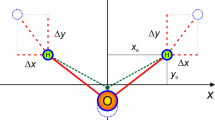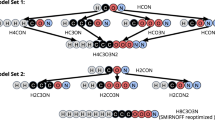Abstract
THE molecular force field which has been most successful in accounting for molecular vibration frequencies is the ‘simple valency force field'. In many cases, however, this simple field has had to be modified considerably by introducing cross-terms. Most frequently these have been introduced empirically with the sole object of obtaining a good reproduction of the observed frequencies. This procedure is unsatisfactory, because it is often impossible to be sure of selecting the correct cross-terms from those that are possible. There have been a few more valuable attempts to modify the simple valency force field, and account for the cross-terms, which have been based on a more careful consideration of the forces, other than simple valency forces, that may exist in the molecule1. However, recently we have found that a new force field leads to more satisfactory results. We call this the ‘orbital valency force field', and it diifers from the older view in its treatment of angular distortions2; whereas the simple valency force field considers the bending angle by angle, the orbital valency force field treats it bond by bond.
This is a preview of subscription content, access via your institution
Access options
Subscribe to this journal
Receive 51 print issues and online access
$199.00 per year
only $3.90 per issue
Buy this article
- Purchase on Springer Link
- Instant access to full article PDF
Prices may be subject to local taxes which are calculated during checkout
Similar content being viewed by others
References
Urey and Bradley, Phys. Rev., 38, 1969 (1931). Thompson and Linnett, J. Chem. Soc., 1392 (1937). Linnett, J. Chem. Phys., 8, 95 (1940). Thorndike, Wells and Wilson, J. Chem. Phys., 15, 157 (1947). Coulson, Duchesne and Manneback, Nature, 160, 794 (1947). Heath and Linnett, Trans. Farad. Soc., in the press.
Heath and Linnett, Trans. Farad. Soc. (in the press). We have recently found that a similar field was suggested by Howard and Wilson for PCl3 type molecules, J. Chem. Phys., 2, 620 (1934).
Pauling, J. Amer. Chem. Soc., 53, 1367 (1931).
Lennard-Jones, Proc Roy. Soc., A, 106, 463 (1924).
Anderson, Lasettre and Yost, J. Chem. Phys., 4, 703 (1936).
Heath and Linnett., Trans. Farad. Soc. (in the press).
Author information
Authors and Affiliations
Rights and permissions
About this article
Cite this article
HEATH, D., LINNETT, J. A Suggested New Force Field for Molecular Vibrations. Nature 161, 314–315 (1948). https://doi.org/10.1038/161314b0
Issue Date:
DOI: https://doi.org/10.1038/161314b0
This article is cited by
Comments
By submitting a comment you agree to abide by our Terms and Community Guidelines. If you find something abusive or that does not comply with our terms or guidelines please flag it as inappropriate.



